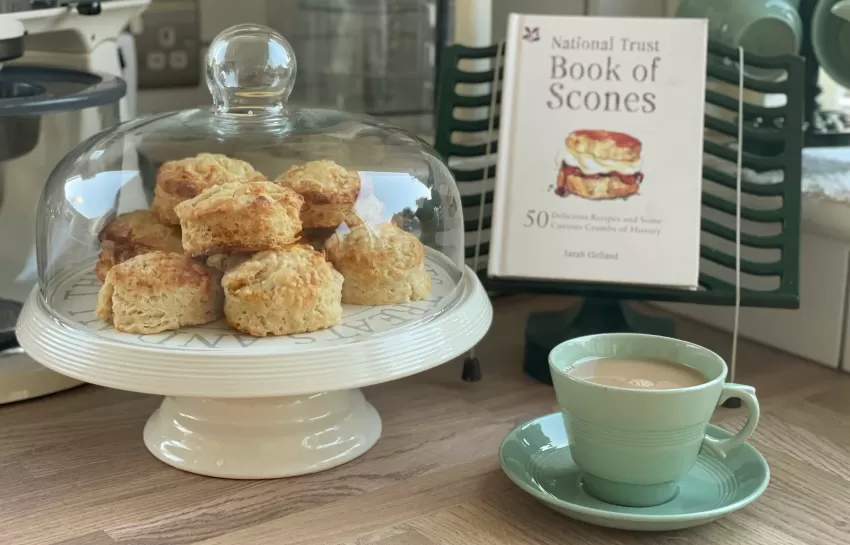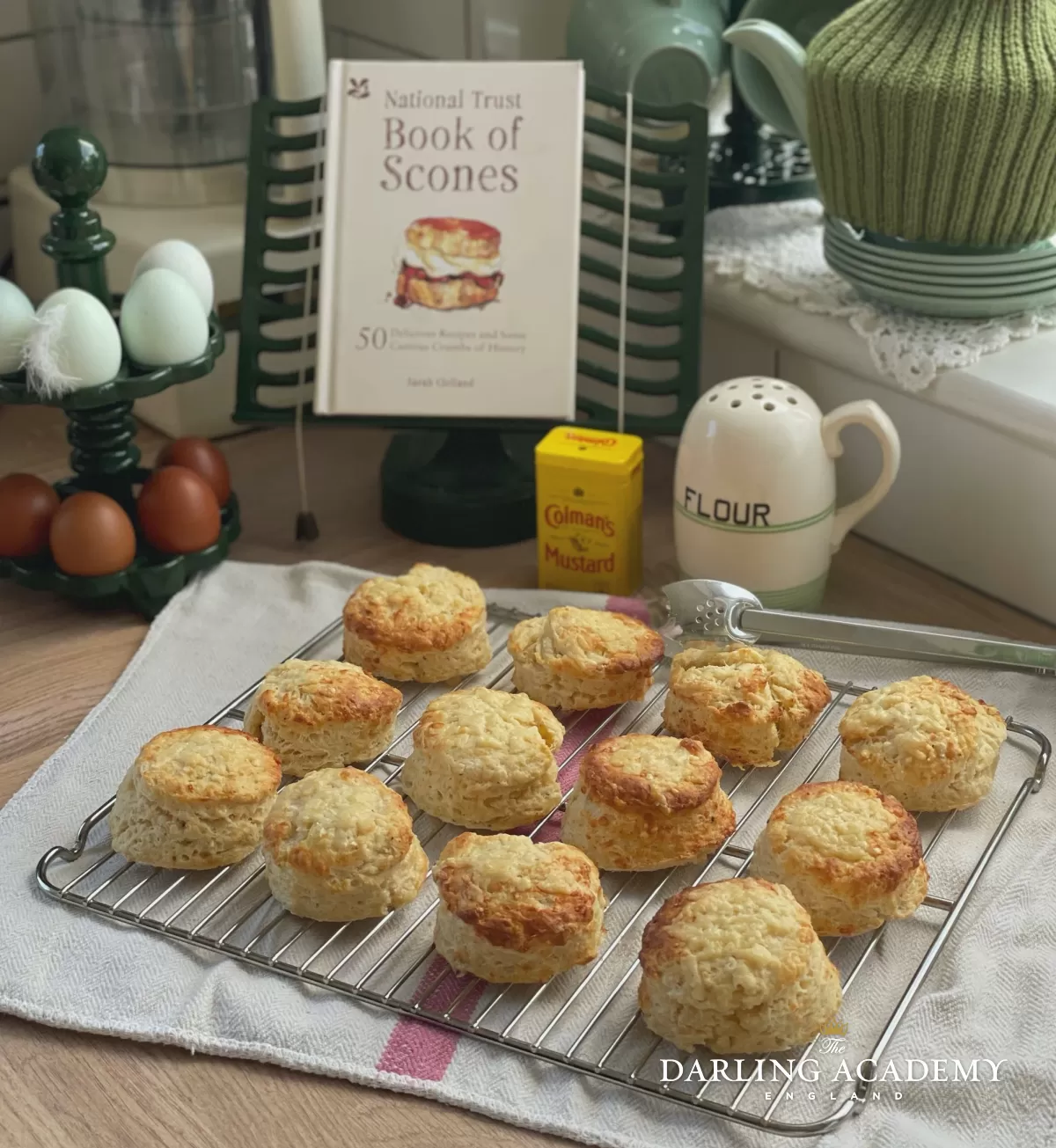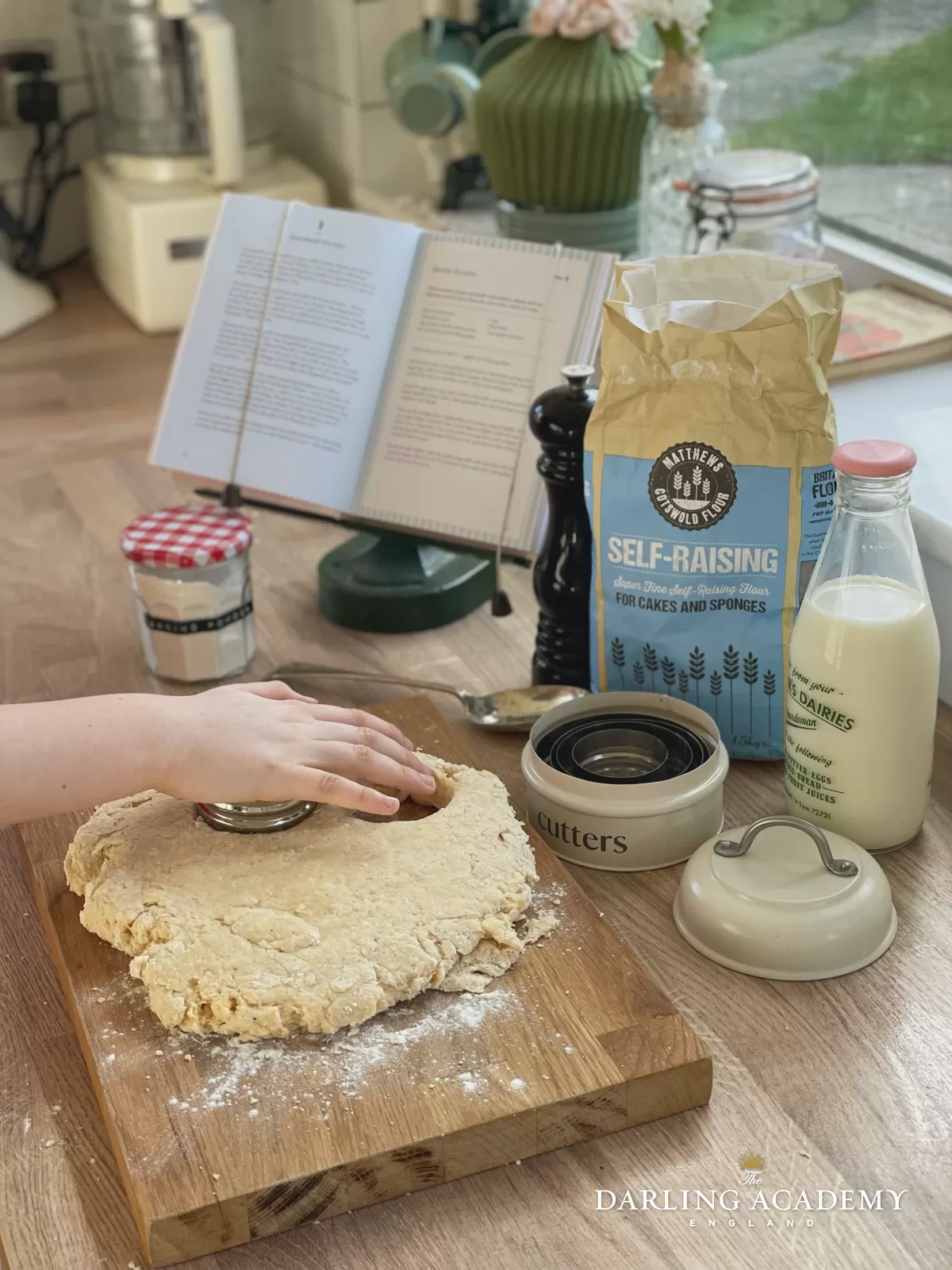Mrs Darling's Cheese Scones recipe

One day when I’m an empty nester, I shall own a Tea Room. A quaint little setting, perhaps in a pretty village, selling lovely lunches, tea and cakes, and you can even pop in for “just” a pudding after dinner if you like.
It will have roses over the door, and inside is bedecked in bunting, a portrait of The Queen will preside over all visitors, and the centrepiece will be a big cream Aga that not only heats the place, but ‘tis where we bake our famous cakes and scones! Perhaps too, keeping your teapot warm in its cosy.
Well, this is what I tell Mr Darling anyway, to excuse the fact that my 1940s Wood’s Ware Beryl collection is now overtaking his precious shelving in the garage (it’s that pretty minty green china in the pictures). “Mrs Darling’s Tea Room” needs all the wartime utility china it can lay it’s hands on you see… If you’ve been left some by your Granny and it’s not your cup of tea, please feel free to drop it to my door! Especially if you’ll take baked goods as payment…
![]()
This week my son and I made a batch of Cheese Scones. I’ve been threatening to make these for a couple of weeks now, but as I’m sure you’ll know dear homemaker - sometimes the business and busyness of life get in the way of the finer and charming aspects of keeping a home, like baking - “just because”.

I thought I’d share this recipe with you, because it’s always good to have up one’s sleeve (and not all guests and homemakers have a sweet tooth). I’ve written about scones before so it only seems fair to add a savoury sister to the mix.
The recipe for these scones has been adapted from a book I already own, but I think made better by a few of “Mrs Darling’s twists” to the receipt… She likes to mess about with things sometimes, often they work, sometimes they don’t, and that my friends, is the joy of cooking!
![]()
English Cheese Scone recipe
Remember that scones are not as hard to make as you might think - the secret is not to overwork the dough, nor ‘twist’ the cutter when you press out the rounds. A nice even vertical pressure is best.
Yield: 8-12 medium sized scones. Size dependent on diameter of cutter.
Serves: 8 people, or a few greedy ones.
Storage: Not suitable for freezing. Best eaten fresh. They’ll last for a maximum of three days if kept in an airtight container.
Cheese Scones ingredients:
- 450g (2 ¾ cups) of Self-Raising Flour. Plus extra for dusting.
- 115g (½ cup) Butter, cubed.
- 140g (1 ¾ cups) grated Mature English Cheddar (the really strong, crumbly sort - I used Davidstow). Americans, try a Welsh Cheddar, Kerrygold, or Cabot Extra Strong.
- A little extra cheese for the tops of the scones, grated.
- 1 tsp Baking Powder.
- 1 tsp Dried English Mustard. I use Coleman’s.
- 2 Medium Eggs.
- 200ml (1 cup) Milk.
- A little extra milk, or a beaten egg for glazing.
Don’t forget our Kitchen Management Manual can help you with all inter-national kitchen conversions!
How to make Cheese Scones
- Preheat your oven to 200°C or 400°F (Gas Mark 6).
- Lightly grease a flat baking sheet with butter, then dust lightly with flour. Or use a silicone liner (no need to grease or flour).
- Measure the flour and baking powder and sift into a bowl, season with salt and pepper, then with cold hands or a pastry blender, rub in the cubed butter until it resembles fine breadcrumbs.
- Now mix in your cheese to the dry ingredients, reserving around 25g of cheese for the topping.
- In a separate jug whisk together the milk, eggs, and mustard powder.
- Gradually add the milk mixture, stirring all the time. If it is too dry to come together (but not yet sticky) keep adding a little more milk. You want a dough that is dry to the touch, and forming a ball, but not sticky.
- Turn out the dough onto a work surface or large board, well dusted with flour.
- Gently flatten the dough with your hands until it is 1 inch thick.
- Using a round cutter*, press rounds out of the dough. Make sure not to twist the cutter, or cut at an angle as this will hinder the ‘rise’.
- Gather up the dough and press out again in order to cut more from the dough - but try not to overwork it.
- Gently transfer the scones onto the baking sheet, leaving a good inch between them.
- With a little milk or a beaten egg, brush the tops of the scones to glaze, then top with grated cheese. Note: using a beaten egg yolk will provide more of a ‘golden’ finish.
- Place on the middle shelf of the oven for 12-15 minutes until well risen and golden brown on top.
- Once beautifully risen and browned, carefully remove from the oven, and place on a wire cooling rack for 10 minutes.
*Or you can cut the round into equal wedges, like you would a pizza.

Cheese scones are best eaten warm with a knob of melting butter, and are fabulous as an accompaniment to soup. Re-heat in a hot oven for a couple of minutes, or microwave for 30 seconds.
Happy Baking!

Scone Resources
My Darling approved kitchen products;
- The National Trust Book of Scones
- Scone and biscuit cutters (similar)
- Cream cake stand with dome (similar)
- Mason Cash silicone baking mat
- Gripstand mixing bowl (mine is vintage but this is the updated version)
- Pastry blender (mine is vintage, but this is similar).
- Matthew’s Cotswold Flour (highly recommended, found in Tesco)
I hope you enjoyed this recipe and it works out well for you!
If all else fails, head to, or order from our beautiful British institution Betty’s!
If you like our values here at The Darling Academy and found this post useful or inspiring, would you kindly consider supporting the blog.
All content and images in this article are copyright of The Darling Academy and are not to be shared or reproduced without our express permission. Affiliate links have been used in this post.



